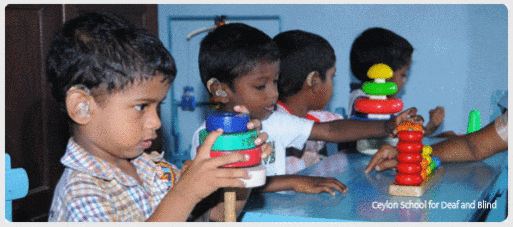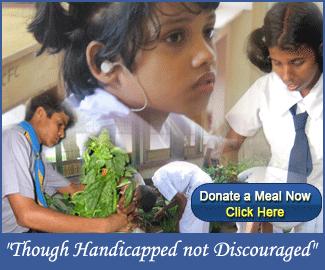-
The Sight Impaired Nursery
-
Children enter the Nursery section from the age of 2 years. They spend the first few years learning to identify shapes and the objects around them, and to read Braille.
-
The Sight Impaired Primary
At the primary school, apart from a general education, the students are taught Sinhala Braille and Standard English Braille. -
However, the pupils prefer Sinhala since they communicate vocally in this language. By the age of 12 years they are quite adept at this means of communication. When the young children first come to school it is a very difficult time for them. They are away from their family for the first time, in an unfamiliar environment, which for a blind or partially sighted child is a cause for much insecurity. The school often allows a child's mother to stay in the school for a few days after a child is admitted, to help the child settle down. Often the children aren't very independent on arrival, but become so as they settle in, Apart from the subjects, they also learn to interact with other children. They learn to dress by themselves, to find their way around the school, and become quite independent in the secure school environment. The very young children wash a few of their clothes, but generally the matrons do such tasks for them. It can take a new child some time to get used to the school environment, and to get over missing their family. They learn a great deal every day, and through repeated learning experiences form ideas about life, the world, and their place in it.
.
-
Secondary Education
The focus in Secondary Education is to prepare students for the General Certificate of Education "Ordinary" level examination. -
The syllabus, is so wide that even in mainstream schools, it is not possible to cover this syllabus in the time available. The GCE 'O' level syllabus for sight impaired students is the same as for all other students.
.
At our school, we have introduced Computer Assisted Classroom Teaching and Multimedia techniques to assist the teacher to present a lesson.
Classroom teaching also employs Braille for all students, and large print books for low vision students.
-
Library
The School has a modern Library equipped with Desktop Magnifiers, Talking Book Readers etc. -
Information Technology, especially the use of computers has greatly enhanced the opportunities for the blind to participate in many of the activities which have up to now been restricted to the sighted. New technology has now enabled students to read daily newspapers online using special software and equipment. Specially developed Word Processing programmes enable the blind to communicate with those who do not Braille! The blind student types out in Braille and the document is printed in either English or Sinhala. An extension of this enables the blind to send and receive emails. We are currently working on a programme to enable the blind to surf the internet. .
.
-
Braille Printing
The children follow the Government curriculum for their studies. -
Printed text books for all classes are provided by the Government as for all other schools, however except some low vision children who might be able to read the printed text books, the blind children cannot read plain text, and have to be provided with the Braille translations.
The school is equipped with a Braille printing room, where the printed text books are converted to Braille. This is done by typing out the entire text book and converting to Braille by using a software, and thereafter printing the converted Braille text, using Braille printing machines.

Managed by Four Corners Lanka (Pvt) Ltd.




